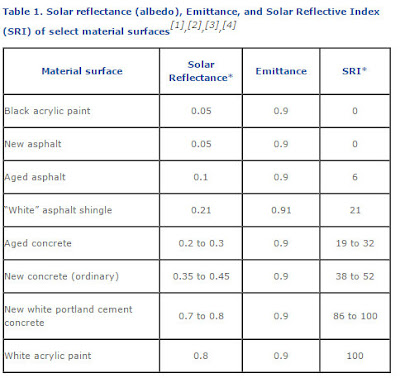Cement produced to be as white as it can be is going to provide ALBEDO to any city that experiences the "heat island effect."
...Concrete surfaces (click here) can earn a LEED for New Construction and Major Renovation (LEED-NC version 2.2) credit through Sustainable Sites Credit 7.1: “Heat Island Effect, Non-Roof”. The intent of this credit is to reduce the heat island effect. The intent can be met if materials that stay cool in sunlight are used on at least half of the site’s non-roof impervious surfaces, such as roads, sidewalks, courtyards, and parking lots (hardscape). The material’s solar reflectance index (SRI) must be at least 29. Where paved surfaces are required, using materials with higher SRI will reduce the heat island effect, consequently saving energy by reducing demand for air conditioning, and improve air quality. Concrete and concrete pavers are ideally suited to meet this requirement. Ordinary portland cement concrete has an SRI in the range of 38 to 52, although it can vary. However, unless it is actually measured, LEED allows an SRI of 35 for ordinary portland cement concrete (see the LEED-NC Reference Guide). New concrete made with white portland cement has an SRI of 86 according to the Reference Guide....
...Albedo, which in this case is synonymous with solar reflectance, is the ratio of the amount of solar radiation reflected from a surface to the total amount reaching that surface. The solar radiation reaching an object on earth includes visible and ultraviolet light and infrared radiation. Ordinary portland cement concrete generally has a solar reflectance of approximately 0.35 to 0.45 although values can vary. The solar reflectance of new concrete is greater when the surface reflectance of the sand and cementitious materials in the concrete are greater. Surface finishing techniques and drying time also affect solar reflectance. Solar reflectance is most commonly measured using a solar reflectometer (ASTM C1549) or a pyranometer (ASTM E1918)....

